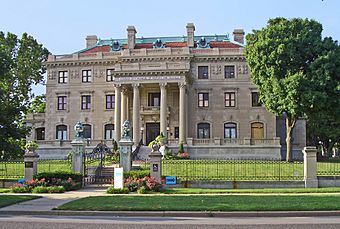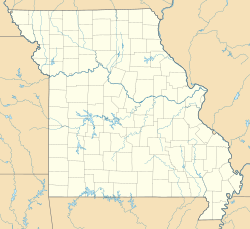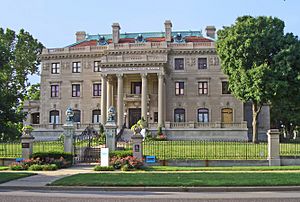Kansas City Museum facts for kids
Quick facts for kids |
|
|
R. A. Long House
|
|

The Kansas City Museum at Corinthian Hall
|
|
| Location | 3218 Gladstone Blvd., Kansas City, Missouri |
|---|---|
| Area | 3-acre (12,000 m2) |
| Built | 1909 |
| Architect | Henry F. Hoit |
| Architectural style | Beaux Arts |
| NRHP reference No. | 80002366 |
| Added to NRHP | November 14, 1980 |
The Kansas City Museum is a cool place to visit in Kansas City, Missouri, USA. It's inside a beautiful old house called Corinthian Hall. A rich lumber businessman named Robert A. Long built this huge house for his family in 1910. It's designed in a fancy style called Beaux-Arts. Later, in 1940, his family gave the house away so it could become a public museum. About 75 years after that, the museum started a big project to fix up and improve the building.
Contents
The Story of Corinthian Hall
Building a Grand Home
The Kansas City Museum is located on a large property that is about 3 acres big. This property includes the main house, Corinthian Hall, and other smaller buildings. The house got its name from the fancy Corinthian columns you can see on it.
Robert A. Long built this amazing house for his family. It was finished in 1910 and cost about $1 million back then. That would be a lot more money today! A local architect named Henry F. Hoit designed the house.
Corinthian Hall is a four-story mansion. It has a huge amount of space, about 35,000 square feet in total. About 24,292 square feet of that was living space for the family. The Long family lived there until Robert A. Long passed away in 1934.
From Home to Museum
After Robert A. Long died, his daughters, Sally and Loula, took some of the decorations and special parts from the house. They put these items in their own homes. Then, they held a big auction in late 1934 to sell everything else that was left.
Because of this, not much of the original furniture or decorations remained. Some rooms even lost their special architectural details. This made the building less valuable as a "historic house" in some ways.
However, the Long daughters still wanted the estate to be used for the public good. So, in 1939, they gave the property to the Kansas City Museum Association. In 1940, it officially opened its doors as a history and science museum for everyone to enjoy.
Becoming a City Museum
Later, the museum faced some money problems. Because of this, the museum was given to the City of Kansas City, Missouri, in 1948. This meant the city would now be in charge of running and taking care of the museum.
Museum's Focus Over Time
Natural History Exhibits
In the 1950s, the museum became very popular for its natural history displays. They had many stuffed animals shown in realistic scenes called dioramas. These displays were so popular that they expanded into the basement in 1951.
The museum also showed off collections of fossils, rocks, and minerals. During its busiest years in the 1950s and 1960s, the museum offered classes and presentations. They even taught people about taxidermy, which is the art of preparing, stuffing, and mounting animal skins.
Fun Features for Visitors
The Kansas City Museum had some unique attractions that made it a fun place to visit. It had a small planetarium with 50 seats where visitors could learn about stars and planets. There was also a 1910-style soda fountain. Here, you could buy old-fashioned drinks like phosphates and ice cream.
Looking for More Space
By the 1970s, the museum staff realized that the building was getting too small. They wanted to show more about local history and science. So, they started thinking about splitting the museum into different locations.
Museum staff and city leaders thought about using the empty Union Station as a new home for a science museum. This would allow the Kansas City Museum to focus more on local history.
Recent Changes and Management
From 2005 to December 2013, another organization managed the museum. This group was Union Station Kansas City, Inc., which also takes care of Union Station.
In January 2008, the main buildings of the museum, the house and carriage house, closed for big renovations. They fixed the roofs, stone work, and special art glass windows. They also added energy-efficient windows, a new elevator, and updated heating and cooling systems.
Since May 2014, the City of Kansas City, Missouri, and its Parks and Recreation Department have been in charge. They now operate and manage the Kansas City Museum, making sure it continues to be a great place for everyone.




